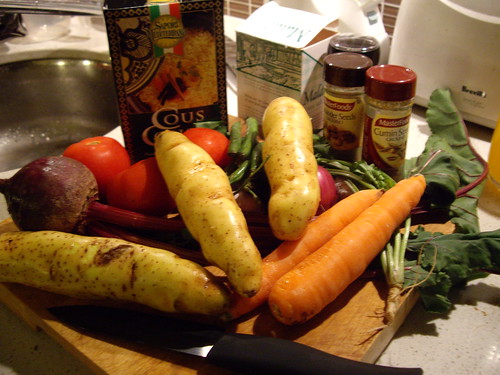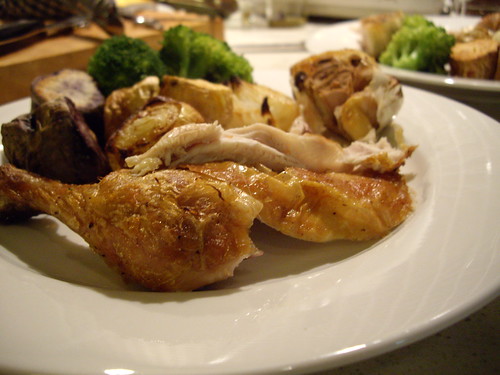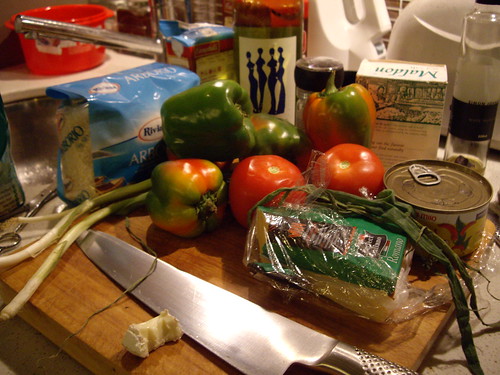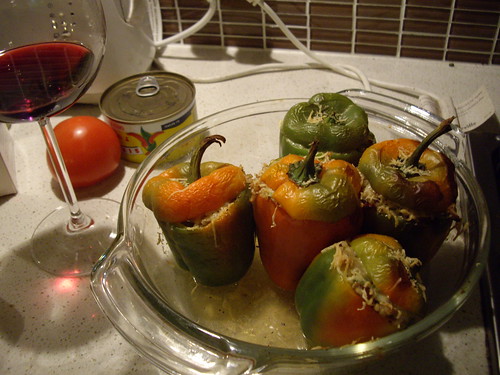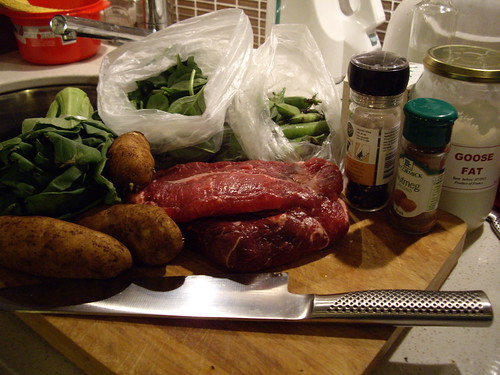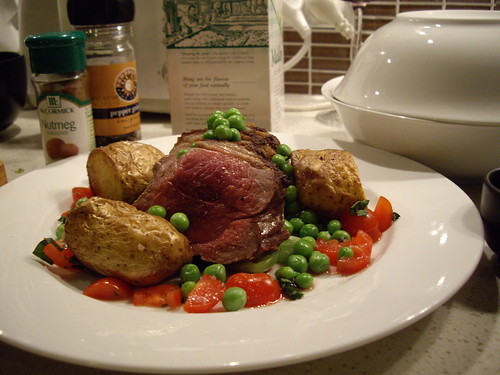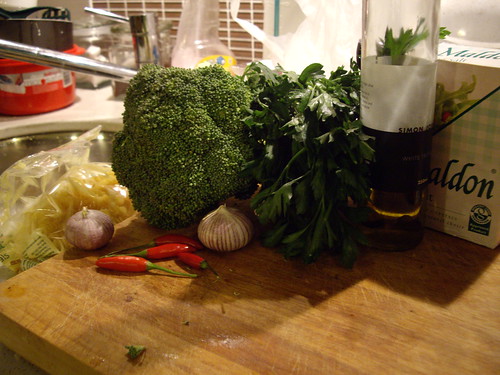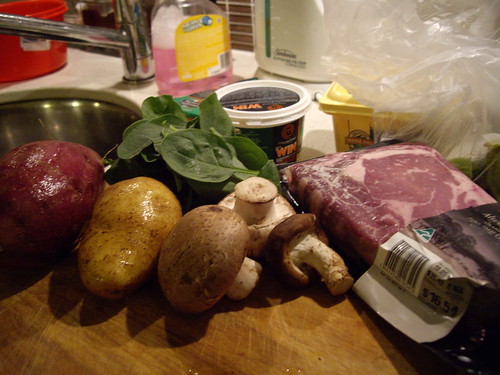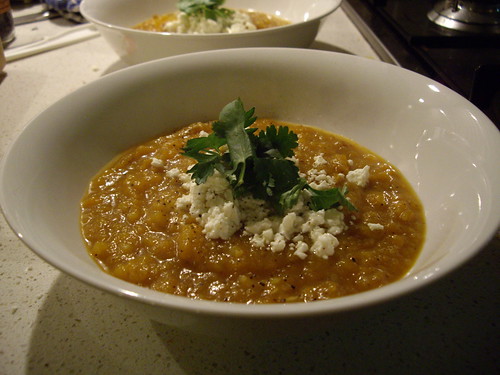Mind you, the whole point of having good ingredients on hand, such as organic veg, high quality olive oil and a good supply of fresh herbs is that even the most simple of dishes is going to be pretty tasty. Or at least good for you...
Since this has been that very week, I present to you my latest assemblage!
Roast vegetables on couscous with Moroccan tomato sauce
There are four very simple components that go together to make this, and you'll end up with a hearty, filling, tasty and very likely nutritious dish that looks a lot fancier than it is. You've got roast vegetables, a bed of couscous, the tomato-based sauce, and some greens to add visual interest and in this case a really interesting flavour and mouth feel.
ingredients
Two kipfler potatoes
Two carrots
Four single clove garlic
One garlic clove
One whole beetroot (reserve the leaves)
Green beans
Ripe tomatoes
Coriander
Small red onion
Ground cumin
Ground coriander seeds
Cup of couscous
Half a cup of chicken stock
Salt & pepper
Olive oil
Tackle the longest step first - chop up your veg for roasting, peel the single clove garlic (don't bother chopping) and toss through some olive and season with salt and pepper. Get it going at normal roasting temp for your oven, and move on to the other ingredients.
For the tomato sauce you need to get a three tablespoons of olive oil heating in a pan, and then add finely chopped red onion. As it's starting to soften, add more salt and pepper, the ground cumin and coriander, and chopped fresh coriander. Finely chop up the tomatoes - about three medium size will do you - and add to the pan.
Add a touch more oil if the sauce is looking too dry, and cook the tomato down.
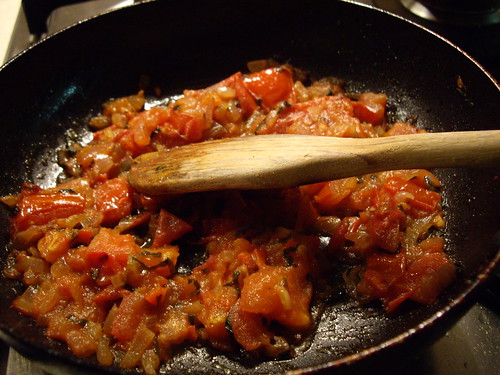
When that's done, transfer to a bowl and put aside. Next!
The couscous can take a little time, so get that going next. Simply add a cup to a sauce pan, and then pour over a cup of hot water out of the tap and the stock - so that's half a cup of water, half of stock. This needs to rest, and let the couscous soak up the liquid, so get cracking on the greenery!
You could use english spinach here, but since we've got the leaves from the beetroot - and they are edible - there's no sense in wasting them. Chop the crunchy stems up into inch long sections, add to the pan you've just removed the sauce from, along with a bit more oil and some sliced garlic. Roughly tear the leaves into two or three pieces, and after a minute or two add them to the stems. When the leaves start to wilt, the stems should be cooked but still crunchy, and garlic should just be browning. Take off the heat, and arrange around two plates.
Brush the green beans with some olive oil, and toss on top of the roasting veg.
The couscous is ready to heat now, so add either some rancid butter, olive oil or a dash of blue cheese. Rancid butter is traditional, but not something you can usually sell your friends on ("It's rancid-fresh!") - even traditional cooks tend toward the blue cheese option these days, and it delivers a similar complex flavour. Olive oil will do, and since you've used stock the couscous will be tasty regardless.
Warm the couscous over a low heat the stove, mixing whatever ingredient you've added thoroughly. Stir constantly, as you don't want it to stick and burn on in the ban. Taste test, then plate it up in a mound in the center of the plate.
Your veg should be done by now, so take it out of the oven and make a tasty stack on top of the couscous. Pour the tomato sauce over the veg, and the job's a good 'un.
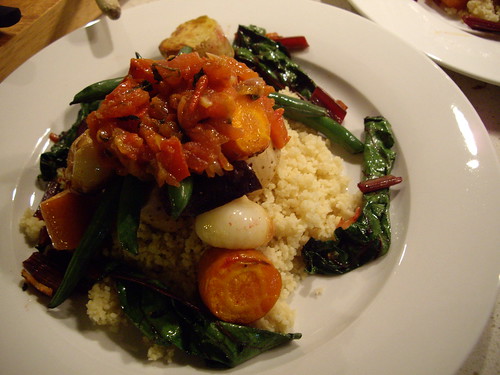
And pretty tasty, too, though I really did wish I had some blue cheese on hand for the couscous - there are some very heavy, stolid flavours in this dish and the cheese would have given the meal some needed bite.
The big success, however, were the beetroot leaves, which have a lovely fulsome nutty flavour. It's not dissimilar to spinach, so I suspect the leaves would be even better with a dash of nutmeg. My friend Blu has an excellent warm beetroot leaf salad with crunchy croûton that I'm going to have to try some time.
Otherwise this a great meal after a long cold day - warming, filling, and pretty damn healthy to boot.
